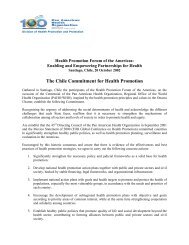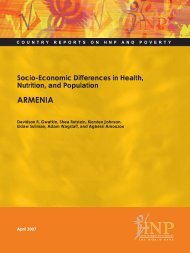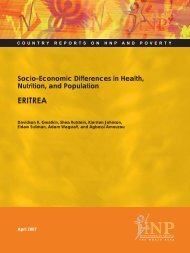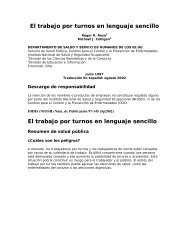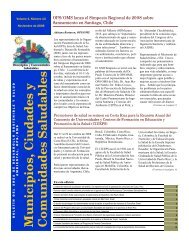Guidelines for drinking-water quality. Volume 1 - BVSDE
Guidelines for drinking-water quality. Volume 1 - BVSDE
Guidelines for drinking-water quality. Volume 1 - BVSDE
Create successful ePaper yourself
Turn your PDF publications into a flip-book with our unique Google optimized e-Paper software.
on the basis of occupational exposure and inhalation studies in laboratory animals. There are no<br />
adequate studies by which to judge whether it is carcinogenic by oral exposure.<br />
Beryllium has been shown to interact with DNA and cause gene mutations, chromosomal<br />
aberrations, and sister chromatid exchange in cultured mammalian somatic cells, although it has<br />
not been shown to be mutagenic in bacterial test systems.<br />
There are no suitable oral data on which to base a toxicologically supportable guideline value.<br />
However, the very low concentrations of beryllium normally found in <strong>drinking</strong>-<strong>water</strong> seem unlikely<br />
to pose a hazard to consumers.<br />
Boron<br />
Elemental boron is used principally in composite structural materials, and boron compounds are<br />
used in some detergents and industrial processes. Boron compounds are released into <strong>water</strong><br />
from industrial and domestic effluents. Boron is usually present in <strong>drinking</strong>-<strong>water</strong> at<br />
concentrations of below 1 mg/litre, but some higher levels have been found as a result of<br />
naturally occurring boron. The total daily intake of boron is estimated to be between 1 and 5 mg.<br />
When administered as borate or boric acid, boron is rapidly and almost completely absorbed from<br />
the gastrointestinal tract. Boron excretion occurs mainly through the kidney.<br />
Long-term exposure of humans to boron compounds leads to mild gastrointestinal irritation. In<br />
short- and long-term animal studies and in reproductive studies with rats, testicular atrophy has<br />
been observed. Boric acid and borates have not been shown to be mutagenic in various in vitro<br />
test systems. No increase in tumour incidences have been observed in long-term carcinogenicity<br />
studies in mice and rats.<br />
A TDI of 88 µg/kg of body weight was derived by applying an uncertainty factor of 100 (<strong>for</strong> interand<br />
intraspecies variation) to a NOAEL, <strong>for</strong> testicular atrophy, of 8.8 mg/kg of body weight per<br />
day in a 2-year diet study in dogs. This gives a guideline value <strong>for</strong> boron of 0.3 mg/litre (rounded<br />
figure), allocating 10% of the TDI to <strong>drinking</strong>-<strong>water</strong>. It should be noted, however, that the intake of<br />
boron from food is poorly characterized and that its removal by <strong>drinking</strong>-<strong>water</strong> treatment appears<br />
to be poor.<br />
Cadmium<br />
Cadmium metal is used in the steel industry and in plastics. Cadmium compounds are widely<br />
used in batteries. Cadmium is released to the environment in waste<strong>water</strong>, and diffuse pollution is<br />
caused by contamination from fertilizers and local air pollution. Contamination in <strong>drinking</strong>-<strong>water</strong><br />
may also be caused by impurities in the zinc of galvanized pipes and solders and some metal<br />
fittings, although levels in <strong>drinking</strong>-<strong>water</strong> are usually less than 1 µg/litre. Food is the main source<br />
of daily exposure to cadmium. The daily oral intake is 10-35 µg. Smoking is a significant<br />
additional source of cadmium exposure.<br />
Absorption of cadmium compounds is dependent on the solubility of the compounds. Cadmium<br />
accumulates primarily in the kidneys and has a long biological half-life in humans of 10-35 years.<br />
There is evidence that cadmium is carcinogenic by the inhalation route, and IARC has classified<br />
cadmium and cadmium compounds in Group 2A. However, there is no evidence of<br />
carcinogenicity by the oral route, and no clear evidence <strong>for</strong> the genotoxicity of cadmium.<br />
The kidney is the main target organ <strong>for</strong> cadmium toxicity. The critical cadmium concentration in<br />
the renal cortex that would produce a 10% prevalence of low-molecular-weight proteinuria in the<br />
general population is about 200 mg/kg, and would be reached after a daily dietary intake of about<br />
175 µg per person <strong>for</strong> 50 years.




